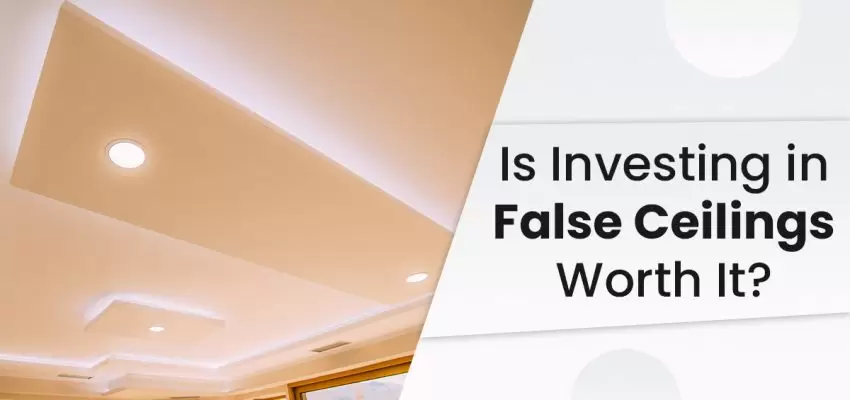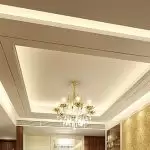A false ceiling, also known as a secondary or dropped ceiling, has become a popular choice among homeowners for its functional and aesthetic benefits. In this comprehensive guide, we’ll delve into the basics of false ceilings, the various types available, and whether opting for a false ceiling design is necessary. We’ll also explore the advantages and disadvantages of incorporating false ceilings into your space and discuss trendy design options.
Post your Requirement
What is a False Ceiling?
A false ceiling is a suspended structure created with the help of wooden or metal rafters to which a ceiling board is fitted. It offers a versatile canvas for various designs, available in a range of colors, materials, sizes, and patterns. The primary purpose of a false ceiling is to enhance the overall aesthetics of a room while addressing practical issues.
Types of False Ceilings
Here we have mentioned the types of false ceilings:
-
Gypsum: Environmentally friendly and easy to install, gypsum boards are known for their fire-resistant features.
-
Plasterboard: Similar to gypsum but more cost-efficient, plasterboard is a popular choice for home renovations.
-
POP (Plaster of Paris): Durable and suitable for intricate designs, POP is a cost-effective option for unique ceiling shapes.
-
Wood: Wooden false ceilings add warmth to a room, but they may pose challenges in humid areas due to expansion and contraction.
-
Metal: Known for strength but susceptible to corrosion, metal ceilings are made with durable materials.
Is a False Ceiling Design Necessary?
While false ceilings are not a necessity in modern interior design, they offer several advantages that may make them worthwhile for specific needs. Livspace designer Samuel Tan suggests considering the following factors:
Advantages of False Ceilings
The advantages of installing false ceilings typically include:
-
Great Acoustics: Additional layers enhance room acoustics, making false ceilings ideal for living rooms and home theaters.
-
Wire Concealment: Hide wires and cables seamlessly within the false ceiling, offering a neat and organized look.
-
Proportional Adjustment: Lower lofty ceilings to restore proportions, providing an aesthetically pleasing change without altering the structure.
-
Insulation: Create a gap between layers for improved insulation, reducing energy bills and optimizing air conditioner efficiency.
Disadvantages of False Ceilings
Installing a false ceiling demands precision in design, calculation, and execution, necessitating the expertise of professionals and rendering it unsuitable for DIY endeavors. The intricate nature of the process involves considerations such as structural support, wiring, and overall safety, emphasizing the need for specialized knowledge. Moreover, false ceilings are recommended for spaces with ceiling heights of 11 feet or more. This limitation makes them less feasible for compact areas with lower ceilings, as too much detail in the ceiling design can potentially create a cramped appearance. Consulting with experts becomes paramount to ensure a successful and aesthetically pleasing installation.
Trendy False Ceiling Designs
The trendy false ceiling designs are mentioned below:
-
L-Box Design: A minimalist design installed on the perimeter of the actual ceiling, maintaining the same height.
-
Recessed Lighting Combo: Combine false ceilings with recessed lighting for a classic and cost-efficient modern look.
-
Cove Lighting: Use LED lights to create ambient lighting, emphasizing the ceiling or walls in various patterns and colors.
-
Mix and Match Lighting: Combine cove and recessed lights to maximize overhead lighting without compromising space.
-
Themed Rooms with Cornices: Add a vintage touch with cornices, suitable for themed commercial spaces or classic homes.
-
Carpentered False Ceiling: Incorporate wooden elements for warmth and a highlight in the room, requiring a skilled carpenter for installation.
In conclusion, the decision to opt for a false ceiling design depends on individual preferences, needs, and the specific characteristics of the space. While offering numerous advantages, it’s essential to consider potential drawbacks and the feasibility of installation. Whether choosing a minimalist L-box design or experimenting with lighting combinations, false ceilings provide a canvas for creative expression in interior design. As with any home improvement project, seeking professional advice is crucial for a successful and aesthetically pleasing outcome.
FAQs
Q-1. What is a false ceiling and how does it differ from the original ceiling?
A-1. A false ceiling, also known as a dropped ceiling, is a secondary ceiling suspended below the original one. It adds aesthetic appeal, conceals wiring, and offers versatile design options without altering the structural ceiling.
Q-2. What are the advantages of installing a false ceiling in a home?
A-2. False ceilings enhance acoustics, hide unsightly wires, bring down lofty ceilings for proportion, and provide additional insulation. They are particularly beneficial for creating a visually appealing and functionally efficient living space.
Q-3. Are false ceilings suitable for all room sizes, or are there limitations?
A-3. While false ceilings work well in rooms with ceilings 11 feet or higher, they may not be feasible for low-ceilinged spaces. In such cases, partial ceilings in corners or creative design solutions can be considered to avoid a cramped appearance.
Q-4. What materials are commonly used for false ceilings, and how do they differ?
A-4. Materials like gypsum, plasterboard, POP (Plaster of Paris), wood, and metal are commonly used for false ceilings. They vary in cost, environmental impact, and durability. Gypsum is environmentally friendly, while wood adds warmth but may pose challenges in humid areas.
Q-5. Can a false ceiling be installed as a DIY project, or is professional help necessary?
A-5. Installing a false ceiling requires precision in design and installation, making it unsuitable for DIY projects. Expertise is needed to ensure proper support, wiring, and overall safety. Consulting with professionals is crucial to achieve the desired aesthetic and functional results.























Post A Comment